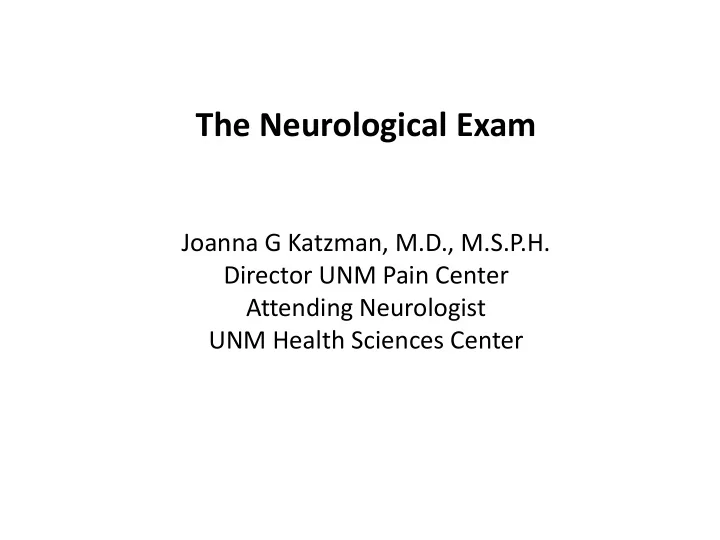

The Neurological Exam Joanna G Katzman, M.D., M.S.P.H. Director UNM Pain Center Attending Neurologist UNM Health Sciences Center
Dr. Katzman has nothing to disclose
Examination of the Central Nervous System After this session, participants will be able to: 1. Understand importance of patient examination of Central Nervous System for pain patients. 2. Learn the basics of actual Central Nervous System exam skills. 3. Understand how the examination of Central Nervous System, can help with differential diagnoses of patients suffering from pain.
THE NEUROLOGICAL EXAMINATION OUTLINE 1. Mental Status 3 . Motor Attention Strength/Power Orientation Tone Naming Deep Tendon Reflexes Language Fine Finger Movements Abstraction Reading 4. Cerebellar Writing Finger to Nose Memory Heel to Shin Frontal Lobe Systems Tasks Balance “Righting Response”, “Checking” Reflex 2. Cranial Nerves 5. Sensory I- Olfactory Light Touch II- Optic Pin Prick III- Oculomotor Vibration IV- Trochlear Proprioception V- Trigeminal (Opthalmic, Temperature Maxillary, Mandibular) Two-point discrimination VI- Abducens Romberg VII- Facial VIII- Acoustovestibular 6. Gait IX-Glossopharnyngeal Heel to Toe X- Vagus Balance/Antalgia XI-Spinal Accessory Functional component XII- Hypoglossal
Neurological Exam • Importance of the History • Patient Centered • Chief Complaint • History of the Present Illness • Psychosocial History • Functional Goals • Medications- current, and past (reason for discontinuation)
Neurological Exam (continued) • Modalities Tried: 1- Interventions 2- Physical Therapy 3- Exercise: how much, what type, how long 4- Massage 5- Yoga 6- Acupuncture 7- TENS unit, biofeedback, hypnosis
Mental Status • Attention 1- Able to answer questions 2- Follow 3 step commands 3- Spell “WORLD” forwards and backwards 4- Repeat 7-digit number 5- Frontal Lobe Tasks 6- Name last 4 Presidents of the United States 7- Counting back by 7, from 100… 93, 86, 79…
Mental Status (continued) • Orientation (person, place, situation) • Naming • Language (receptive, expressive) • Abstraction • Reading • Writing
Cranial Nerves • I-Olfactory Nerve • II- Optic • III- Oculomotor • IV- Trochlear • V- Trigeminal (Opthalmic, Maxillary, Mandibular) • VI- Abducens • VII- Facial
Cranial Nerves (continued) • VIII- Acoustovestibular • IX- Glossopharyngeal • X- Vagus • XI- Spinal Accessory • XII- Hypoglossal
Motor Exam • Strength/Power • Fine Finger Movements • Deep Tendon Reflexes (reflex hammer) • Tone/Spasticity • Differences in motor examination with Upper and Lower Motor Neuron Diseases (examples)
Cerebellar Exam • Finger to Nose • Heel to Shin • “Righting Response” • Balance • “Check” Response • Diseases with Abnormal Cerebellar Exam findings (examples)
Sensory Exam • Touch: Light Touch, Pin Prick • Vibration Sense (Tuning Fork) • Proprioception • Temperature: Cold/Hot • Romberg (dorsal columns---NOT cerebellar)
Gait Evaluation • Heel to Toe • Tandem Gait • Antalgia • Balance • Functional
Functional Pain Scales • Brief Pain Inventory (BPI) • Pain Outcomes Profile • Pain Tracker
16
Recommend
More recommend